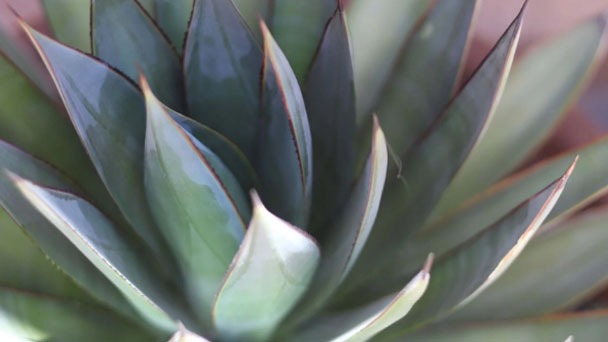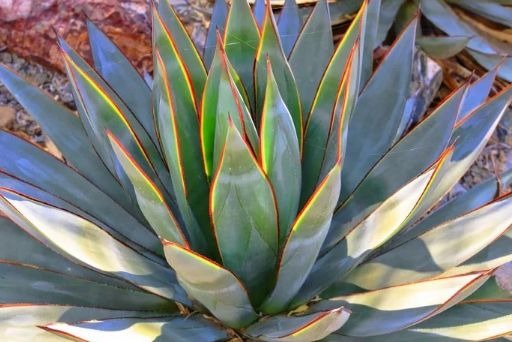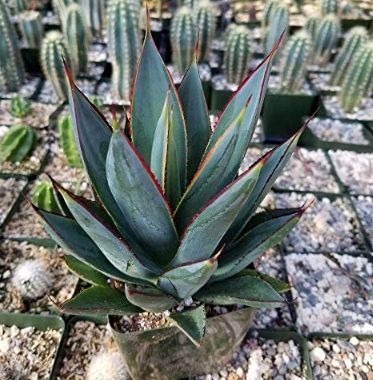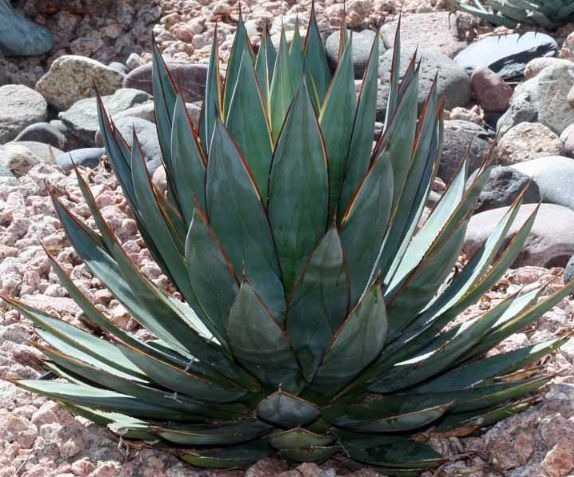Blue Glow Agave - Care & Growing Guide 2023
Written by Ivy
Jan 07 2023

It makes a striking contrast and is the ideal plant for bordering, especially if you want to grow it alongside other outdoor plants. Continue reading to gain a thorough understanding of what is required to cultivate and maintain this type of agave.
It may seem like a lot of work to give your home garden a significant facelift or completely overhaul the landscape. But that wouldn't be the case if you chose a succulent like the Blue Glow plant, which stays robust and vigorous throughout the seasons.
Blue Glow Agave Overview
| Botanical Name | Agave ‘Blue Glow' |
| Common Name | Blue Glow Agave |
| Family | Asparagaceae |
| Plant Type | Succulent |
| Origin | Garden Origin |
| Maintenance | Low |
| Height | 1-2 feet |
| Width | 2-3 feet |
| Light | Full sun, Partial shade |
| Bloom season | Summer |
| Bloom color | Yellow |
| Water needs | Low |
| Soil | Well-Drained, Loamy, Sandy |
| Tolerant | Deer, Drought, Salt |
| Toxicity | Mildly-toxic |
| Hardiness (USDA) | 8-11 |
Agave Blue Glow Plant Care
Compared to other Agave varieties you might encounter, Blue Glow is typically a little bit smaller. It grows up to 18" inches in height but can reach 24" inches if you hone its growing conditions. It also spans to about 2" or 3" feet during its lifetime. Being a succulent with a slow growth rate, spring or the first few weeks of fall are among the best times to propagate your Blue Glow plant.

Size & Growth
Beautiful smaller agave, Blue Glow grows to a height of 18 to 24 inches and a spread of 2 to 3 feet.
The blue-green leaves develop in a single rosette formation with a clumping growth habit.
The leaves are about 18″ inches long and about 1½" inch wide with a red terminal spine.
The stiff, thick, and rigid blue-green leaves have a thin, yellow inner line and bright red toothed margins.
The bright red terminal spine tips are quite sharp, despite the Agave Blue Glow leaves' lack of sharp edges.
Flowering & Fragrance
Similar to the well-known Agave americana, this monocarpic Agave blooms only once and then perishes.
Yellow flowers and red-margined leaf tips with small, soft spines and a short, red terminal spine are both characteristics of the plant.
Each leaf appears to be outlined in a symmetrical rosette by a short red spine.
Plants typically reach maturity when they are ten to fifteen years old when grown outdoors.
Your plant might never bloom at all if kept indoors.
A strong, straight, 10-foot-tall flower stalk develops on mature Blue Glow plants.
The basal rosette's central region is where the flower stalk appears.
Greenish-yellow blooms that are 2 to 3 inches long appear in attractive, showy panicles at its peak.
The plant expires after its final bloom.
Light & Temperature
'A well-lit, well-ventilated environment is necessary for growing blue Glow' Agave. The plant will grow slowly and poorly, taking on a lopsided shape if there is not enough light available. Long-term effects will also have an impact on chlorophyll synthesis, which will cause the leaves to lose their luster and turn yellow and white. Some variegated varieties require adequate summer shading. Otherwise, the leaves will be burned by the direct sunlight and develop spots. The plant's aesthetic appeal will be harmed by these burnt spots, which are irreversible.Even outdoors, sunlight intensity is relatively weaker in the winter. this means you must pay special attention to these changes in the plant's environment. Even in the winter, the plant should be placed where there is sufficient sunlight. In order for the "Blue Glow" Agave to successfully overwinter, such favorable conditions must be provided.
The plant can withstand a little frost, but it needs to be protected from temperatures below 25°F (-4°C).
Agave Blue Glow Water Needs & Feeding
Even though "Blue Glow" can withstand drought conditions, despite having minimal water requirements, it benefits from consistent watering throughout the spring and summer growing seasons.
During the winter, drastically cut back on (or completely avoid) watering.
In extremely hot weather, drink frequently.
This compact Agave is a good choice as a container plant to be brought inside for the winter in regions where it is not winter hardy.
Keep your potted agave in a light, sunny window, and water it sparingly.
Fertilize sparingly because doing so might cause the plant to bloom and then die.
Soil & Transplanting
This succulent can withstand drought and does ok in dry, slightly acidic soil.
It works well in locations with thin, rocky soil.
A stony, sandy, sharp, well-draining soil is the ideal substrate for this Agave.
The Agave Blue Glow Plant enjoys being a little crowded when kept in a pot.
Select a container that is a little bit bigger than the foliage.
Grooming & Maintenance
Agave requires very little to no maintenance and grooming.
Trim lower leaves if they start to wither.
For occasional dust removal, you might want to gently wipe the foliage down with a clean, damp cloth.
Potting and Repotting Agave ‘Blue Glow'
Agave blue glow is simple to pot and repot, even if you've never done it before. When it's warm outside, in the spring or summer is the ideal time to repot Agave Blue Glow. Repotting during the winter is not a good idea because this plant does not grow during that season.
The pot should be slightly larger than the rosette in order to encourage the best growth. Also keep in mind that the Agave Blue Glow grows slowly and only requires repotting every three to four years.
How to Propagate Agave Blue Glow
While the majority of agave species produce pups naturally, you can also make your own by coring the plant. Coring involves drilling a hole through the center of the plant's core, which forces it to produce offsets for survival.

Coring is a hit-or-miss procedure that calls for the death of the parent plant in the hopes of producing pups for the future. If there is nothing else you can do and your plant is dying, only use this method.
Once the plant starts producing pups, you can replant them in a new pot and establish them as individual plants.
Leaves
When Blue Glow is propagated using leaves. (Learn all about Succulent Propagation here.) A leaf from the mother plant should be carefully taken. A healthy leaf with no remaining stem tissue should be present. Propagation will succeed in this manner. Allow it to calluse for a few days before replanting. For your new succulent plant, use well-draining soil. When the soil starts to dry out, don't forget to water.
Cuttings
Take a leaf from the mother plant and carefully cut it off with a clean pair of scissors or a knife when propagating Blue Glow from cuttings. Wait a few days for it to callus before replanting. For your new succulent plant, use well-draining soil. When the soil becomes dry, remember to water.
Offsets
Offsets are where Blue Glow spreads. You may need to wait several years for the mother plant to produce an offset before you can propagate from it. Start by removing an offset from the primary plant with a sharp knife. Clean the offset of extra soil after removing the offset. Wait a few days to let the plant callus before replanting. You should plant your new succulent in well-draining soil. When the soil becomes dry, remember to water.
Seeds
Even though this particular variety of succulent can be propagated by seeds, it is not advised because they grow slowly. Plant the seeds in a soil mixture that drains well to begin propagating from them. You can apply this technique outside. Indoor propagation is advised in colder climates.
When Does Agave Blue Glow Bloom
Agave Blue Glow is monocarpic, meaning it only blooms once before dying. To reach flowering maturity, the plant needs about 10 years.
Once your Agave is ready to bloom, you will see a spectacular 10-foot-tall stalk rising from the center of the basal rosette. Near the tip, the stalk has a small branch, but otherwise it is mostly upright.
Agave Blue Glow produces greenish-yellow flowers that cluster at the stalk's tip. The flowers, however, are amusingly not nearly as attractive as the stalk on which they bloom.
Cross-cutting Issues of the Agave ‘Blue Glow' Plant
Is This Plant Toxic Or Invasive?
All Agaves exude a sap that is typically poisonous. When consumed, the Blue Glow plant may upset your stomach. Its sap may also irritate your skin. Inflamation can be reduced by washing the irritated area with water. This variety doesn't spread quickly because it is a hybrid and slow-growing plant.
Overwatering
Overwatering is the number one cause of agave death. So, instead of watering frequently, agaves should be watered only when the soil is dry. You shouldn't use a sprinkler or hose to water agave plants; instead, you should water them by hand.
Agaves require watering about once per week in the summer and just occasionally in the cooler months. During the winter, don't water your agave too much!
Sunburn
Sunburn is caused by overexposure to the sun. It can be avoided by putting the plant in a shaded area or one where it will get indirect light in the morning and late in the afternoon. Prevent being exposed for too long to the harsh afternoon sun, which can cause serious harm.
Frost Damage
When it gets colder than freezing in cold climates, you should bring the agave indoors. Cover it with a blanket or tarp if this isn't an option. Although an agave plant will not be killed by frost, it will also not be able to recover.
Frost damage presents as a white discoloration near the tips of the leaves. Plant parts that are damaged rarely recover.
Gray Mold
Gray mold is a fungus that grows on agaves, especially during wet weather. On the leaves, it appears as gray, cottony masses and causes brown spots and patches. It is best to remove any gray mold from your Agave before it causes further damage.

Suggested Uses of the Agave ‘Blue Glow' Plant
This hybrid is typically an outdoor plant that does well in gardens with rocks. Furthermore, it blends in admirably with the cacti. If it was grown in containers, you could easily bring it inside for the winter. Even in subfreezing conditions, this succulent is capable of surviving.
If it is growing in direct sunlight, its foliage will become more radiant. If you intend to grow it inside a container, you should put it close to a window that receives the most light. Agaves grown indoors don't proliferate widely, so you can use them to improve the aesthetics of your covered balcony or patio.
Latest Updated
- Benefits of Bugleweed - 7 Science-backed Health Benefits
- Bugleweed Dangers & Side Effects - Is It Poisonous?
- How to Plant Evergreen Trees - What You Should Know
- When to Plant Evergreens - Grow Guide for Evergreen Trees
- 12 Wonderful Evergreen Shrubs for Your Garden
- 12 Popular Evergreen Plants with Pictures for Beginners
- When And How To Prune A Lilac Bush Like a Pro
- How to Grow & Care for Lilac Vine (Hardenbergia Violacea)
- Japanese Lilac Tree (Syringa Reticulata) Care & Propagation Guide
- Shumard Oak Pros and Cons - What to Know
Popular Articles
- Winter maintenance of Antirrhinum Majus
- How to Grow Terminalia Mantaly Tree
- How to Grow and Care for Crossostephium Chinense
- How to grow Antirrhinum Majus in spring
- Peristeria Elata (Dove Orchid) Profile: Info & Care Guide
- Underwatered Snake Plant (Sansevieria Trifasciata) - Signs And How To Fix
- How to Care for Brazilian Jasmine Plant (Mandevilla Sanderi)
- How to Grow & Care for Graptopetalum Purple Delight in Summer
- Rosa Chinensis (China Rose): Plant Growing & Care Tips
- How to Care for Baby Sun Rose (Aptenia Cordifolia)